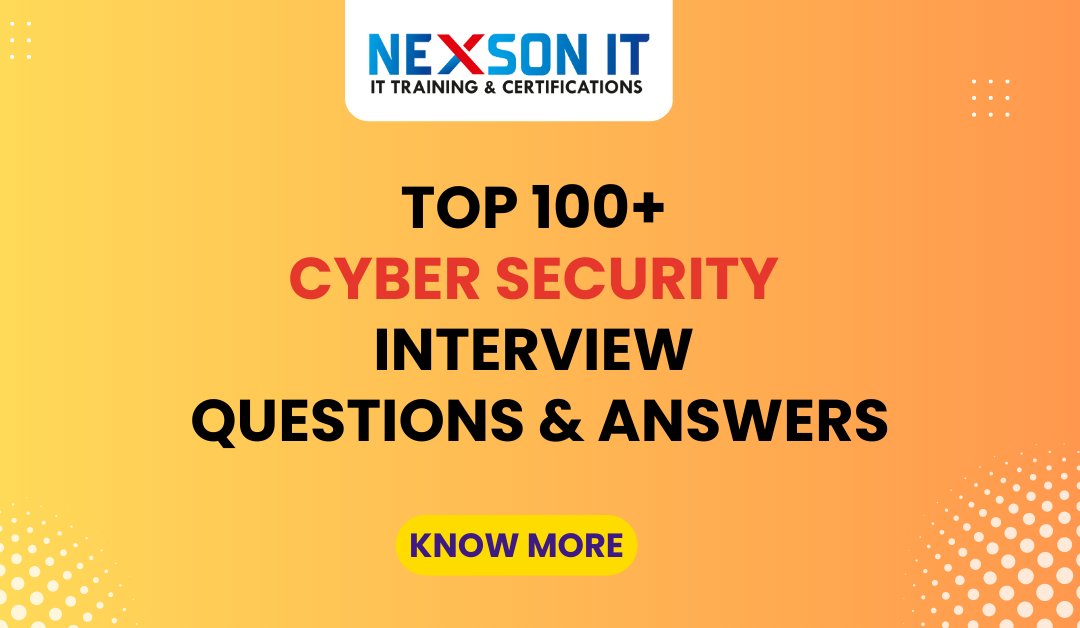Top 100+ Cyber Security Interview Questions and Answers
When preparing for a cybersecurity interview, it is essential to be well-versed with the most common cybersecurity interview questions. Whether you’re a fresher stepping into this dynamic field or an experienced professional aiming for a managerial role, understanding key concepts and how they apply to real-world scenarios is crucial. At Nexson IT Academy, we’ve compiled a comprehensive guide to ensure you’re ready for any interview challenges.
The Importance of Cybersecurity Interviews
In today’s digital-first world, cybersecurity roles have become vital for every organization. The interview process is designed to assess both your technical prowess and your problem-solving ability in high-pressure scenarios. You’ll face questions that range from technical nuances to scenario-based problem-solving, especially for roles like cybersecurity analyst or cybersecurity manager.
Essential Tips to Prepare for Cybersecurity Interviews
1. Understand the Role
Research the specific job description and align your preparation with the role’s requirements. A cybersecurity analyst role, for instance, may emphasize log analysis and threat hunting, while a manager role focuses on designing robust policies and frameworks.
2. Know the Basics
For freshers, it’s important to solidify foundational knowledge. Common cybersecurity interview questions for freshers often include topics like:
- Definitions of cybersecurity terminology (e.g., firewall, VPN, encryption).
- Basics of network security and protocols.
- Understanding of cybersecurity frameworks such as NIST or ISO 27001.
3. Master Advanced Topics for Experienced Roles
Cybersecurity interview questions for experienced professionals focus on:
- Incident response and recovery processes.
- Advanced threat intelligence tools.
- Vulnerability assessment and penetration testing methodologies.
4. Practice Scenario-Based Questions
Scenario-based problems are common, especially for analysts or managers. Expect questions like:
- “How would you handle a ransomware attack on critical systems?”
- “What steps would you take to investigate a potential data breach?”
Tailoring Your Answers for Maximum Impact
Use structured approaches like STAR (Situation, Task, Action, Result) to present your answers.
1. For Cybersecurity Analysts
Demonstrate your ability to:
- Analyze and interpret logs from SIEM tools.
- Detect vulnerabilities in systems and applications.
- Collaborate with other teams to address ongoing threats.
2. For Cybersecurity Managers
Highlight:
- Policy creation and enforcement.
- Risk management strategies.
- Leadership and cross-departmental coordination.
3. For Freshers
Focus on your learning potential, certifications, and enthusiasm for the field. Mention certifications such as:
- CompTIA Security+
- CEH (Certified Ethical Hacker)
- CISSP (Certified Information Systems Security Professional)
Why Employers Ask Top Cybersecurity Interview Questions
Recruiters evaluate candidates not just on knowledge but on practical understanding. They aim to:
- Gauge your awareness of the latest cybersecurity threats and trends.
- Test your critical thinking in resolving issues.
- Assess your communication skills, essential for effectively conveying risks to non-technical teams.
Common Cybersecurity Tools You Should Know
A strong understanding of industry-standard tools can set you apart. Be prepared to discuss your experience with:
- SIEM Tools: Splunk, QRadar.
- Threat Intelligence Platforms: ThreatConnect, Recorded Future.
- Vulnerability Scanners: Nessus, Qualys.
Bonus: Key Topics for Freshers and Experienced Professionals
- Freshers: Networking basics, cryptography fundamentals, OSI model, web application security.
- Experienced Professionals: Advanced persistent threats (APT), forensics, cloud security, zero trust
Nexson IT Academy: Your Partner in Cybersecurity
At Nexson IT Academy, we provide tailored training programs that cater to both beginners and professionals. Whether it’s honing your technical skills or preparing for behavioral questions, our experts will guide you every step of the way.
Boost your chances of success by joining our programs, designed to help you ace any cybersecurity interview.
Introduction:
With the increasing demand for cybersecurity professionals in the digital age, job seekers need to be well-prepared for interviews to land their desired job. Cybersecurity interview questions can be challenging, so it’s essential to have a thorough understanding of the industry, the required skills, and knowledge.
In this article, we have compiled a list of the top 100+ cybersecurity interview questions and answers. We will cover a broad range of topics, from network security to ethical hacking to provide you with a better understanding of the industry’s requirements. Whether you are a fresh graduate or an experienced professional, this list will help you prepare for your cybersecurity job interview and increase your chances of getting hired.
Top Headings:
- Network Security
- System Security
- Ethical Hacking
- Web Application Security
- Cloud Security
- Cryptography
- General Cybersecurity Questions
Sub Headings:
Network Security
a. What is network security?
b. What are the essential elements of network security?
c. What is a firewall?
d. What is an intrusion detection system (IDS)?
e. What is a virtual private network (VPN)?
f. What is a distributed denial-of-service (DDoS) attack?
g. What is a man-in-the-middle (MITM) attack?
System Security
a. What is system security?
b. What is an access control list (ACL)?
c. What is a biometric authentication system?
d. What is the difference between symmetric and asymmetric encryption?
e. What is a security information and event management (SIEM) system?
f. What is a honeypot?
g. What is a rootkit?
Ethical Hacking
a. What is ethical hacking?
b. What is the difference between penetration testing and vulnerability scanning?
c. What is a SQL injection attack?
d. What is a phishing attack?
e. What is a cross-site scripting (XSS) attack?
f. What is a social engineering attack?
g. What is a buffer overflow attack?
Web Application Security
a. What is web application security?
b. What is a cross-site request forgery (CSRF) attack?
c. What is a file inclusion vulnerability?
d. What is a broken authentication and session management vulnerability?
e. What is a command injection attack?
f. What is a server-side request forgery (SSRF) attack?
g. What is a path traversal attack?
Cloud Security
a. What is cloud security?
b. What are the top security risks associated with cloud computing?
c. What is a virtual machine escape vulnerability?
d. What is a cloud access security broker (CASB)?
e. What is a distributed denial-of-service (DDoS) attack?
f. What is a man-in-the-middle (MITM) attack?
Cryptography
a. What is cryptography?
b. What are the different types of encryption algorithms?
c. What is a digital signature?
d. What is a one-time pad?
e. What is a public key infrastructure (PKI)?
f. What is a certificate authority (CA)?
General Cybersecurity Questions
a. What are the most significant cybersecurity threats?
b. What is the difference between confidentiality, integrity, and availability (CIA)?
c. What are the top security measures that organizations can take to protect their networks and data?
d. What is a security policy?
e. What is the role of the cybersecurity professional in an organization?
f. What are the most common types of cyber attacks?
g. What is the difference between vulnerability and risk?
h. What is a security audit?
i. What is the impact of cybersecurity on privacy?
j. What is the role of cybersecurity in compliance and regulations?
Bullet Points:
To provide a better understanding of the topics covered, we have included some sample bullet points for each section.
- Network Security
Network security is the practice of protecting networks from unauthorized access or attacks.
The essential elements of network security are confidentiality, integrity, and availability.
A firewall is a network security device that monitors and controls incoming and outgoing traffic based on predetermined security rules.
An intrusion detection system (IDS) is a device or software application that monitors network traffic for signs of malicious activity.
A virtual private network (VPN) is a secure and encrypted connection that allows users to access a private network over the internet.
A distributed denial-of-service (DDoS) attack is a type of attack that aims to disrupt the normal functioning of a website or network by overwhelming it with traffic.
A man-in-the-middle (MITM) attack is a type of attack where an attacker intercepts communication between two parties to steal information or compromise the network.2. System Security
System security refers to the practice of protecting individual computer systems from unauthorized access or attacks.
An access control list (ACL) is a list of permissions that determines which users or systems have access to specific resources.
A biometric authentication system uses biometric data, such as fingerprints or facial recognition, to authenticate users.
Symmetric encryption uses the same key to encrypt and decrypt data, while asymmetric encryption uses different keys.
A security information and event management (SIEM) system is a tool that collects and analyzes security-related data from multiple sources.
A honeypot is a decoy system that is designed to attract attackers and detect or deflect their attacks.
A rootkit is a type of malware that can hide its presence on a system and provide an attacker with unauthorized access.
3. Ethical Hacking
Ethical hacking is the practice of using hacking techniques for legitimate purposes, such as testing the security of a system.
Penetration testing is the process of simulating an attack to identify vulnerabilities and weaknesses in a system, while vulnerability scanning is the process of identifying potential vulnerabilities without attempting to exploit them.
A SQL injection attack is a type of attack that exploits vulnerabilities in SQL databases to gain unauthorized access to data.
A phishing attack is a type of attack where an attacker masquerades as a trustworthy entity to trick a victim into providing sensitive information.
A cross-site scripting (XSS) attack is a type of attack that injects malicious code into a website to steal information or compromise the site.
A social engineering attack is a type of attack that uses psychological manipulation to trick a victim into divulging sensitive information.
A buffer overflow attack is a type of attack that exploits a vulnerability in a program’s buffer to execute malicious code.
4. Web Application Security
Web application security refers to the practice of protecting web applications from unauthorized access or attacks.
A cross-site request forgery (CSRF) attack is a type of attack that tricks a user into performing an unintended action on a website.
A file inclusion vulnerability is a type of vulnerability that allows an attacker to include and execute files from a remote server.
A broken authentication and session management vulnerability is a type of vulnerability that allows an attacker to hijack a user’s session or gain unauthorized access to a system.
A command injection attack is a type of attack that executes malicious commands on a system by injecting them into a vulnerable application.
A server-side request forgery







Recent Comments